Install Steps
Guide to install quickly, up and running for use in just a minute or two
Home > Outlook Add-ins > SharePoint Publisher for Outlook > Installation Guide – Personal Edition
It typically takes not more than 2 minutes to perform the install and configuration.
With this guide, you would be able to quickly and easily configure AssistMyTeam SharePoint Publisher settings, choose and link destination SharePoint lists with Outlook so that you can start publishing Outlook items to SharePoint in a single click or through automation.

There are two different setups – one each for 32-bit Outlook and 64-bit Outlook
SharePointPublisherSetup_x86.zip (for 32-bit Outlook)
SharePointPublisherSetup_x64.zip (for 64-bit Outlook)
Extract these file contents to a file folder in your system.
A) Files Installation
Step 1. Run the SharePointPublisherSetup_xXX.exe to start the installation. Click ‘Next‘ to Continue. If Outlook 2010 or later is not installed, the setup wizard will not be able to proceed. Please also ensure Outlook is shutdown (if already running or active in the task manager) as the setup has to install an Outlook add-in.

Step 2. Select the appropriate destination folder where the application files will be installed. If you change the default folder path, please make sure you have appropriate permission. (Note: by default, it will be installed under your application data folder)

Step 3. Click ‘Next’ to continue with the files extraction. It just takes a few minutes to complete the whole copying process.

Step 4. Click ‘Finish’. This ends the files installation process in your system.

Now start Microsoft Outlook and you will see a dedicated tab with the title ‘AssistMyTeam SharePoint Publisher’.
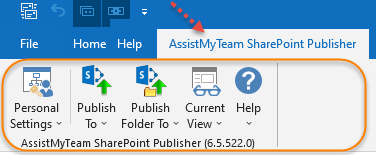
B) Choose Destination SharePoint Lists
Before you can start publishing Outlook emails, appointments or tasks to SharePoint, you need to choose the destination SharePoint lists, to which the captured metadata from Outlook items will be stored as a list item. You will also need to define the mapping or association between the Outlook fields and the SharePoint fields. There are two ways of doing it:
First Technique: Specify SharePoint Lists for Outlook item types
You can define any number of common SharePoint lists that will be used for publishing from any Outlook folder. Commonly configured SharePoint lists and mappings act as a template for all Outlook folders and would appear in the ‘Publish To’ drop down menu in the SharePoint Publisher toolbar or ribbon.
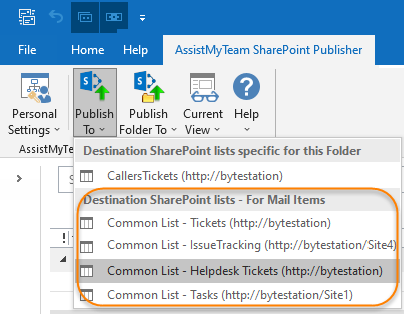
To define a common SharePoint list and mapping for all Outlook folders, go to Personal Settings menu > ‘Configure Common SharePoint lists‘.
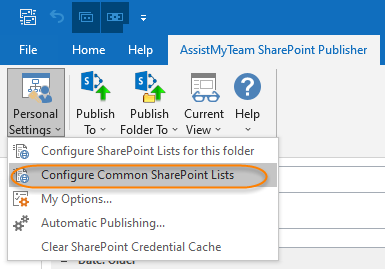
In this common SharePoint lists panel, you can choose for which particular type of Outlook item, will the configured SharePoint list and mapping be associated with. Type of items can be mail, appointment, task, journal or contact.

To link a SharePoint list to a particular Outlook item type, say ‘Mail’, click ‘New SharePoint Link…’.
You will then be prompted to enter the SharePoint site URL.

If the SharePoint site uses the NTLM or windows authentication, the add-in will use the default credential to connect to the SharePoint. However, for form based or claimed based authentication (for example, Office 365 SharePoint online), it may prompts you (and other individual technician) to enter their credential.

In the username, exclude any domain information. For instance, do not enter in the format DOMAIN\UserName. Only enter UserName. Check ‘Remember’ so that Issue Tracker add-in can use the same credential to logon to the SharePoint site in subsequent connection. You can also specify the authentication mode that is used by your SharePoint to allow connection to it. For instance, if your SharePoint is configured for Windows authentication, choose ‘NTLM’. If it used a form-based authentication, then choose ‘Forms’ whereas if it used a claimed based authentication (for Office 365 SharePoint Online), choose ‘Office 365’.
NOTE: Recent changes in Office 365 SharePoint policy mandates that you use an App password for non-browser app like ours (3rd party add-in) instead of your Office 365 login password. This can be generated from your Office 365 page. Refer to this KB article on how to generate and use App password with our add-in – Connecting AssistMyTeam Apps to SharePoint with Office 365 account enabled with Multi-Factor Authentication (MFA).
Once the credential is verified, and it would allow you to choose an existing SharePoint list or create a new list or site directly from the add-in. No need to go to your web browser.
![]() New Site – Create a new site directly under the chosen parent site to be used exclusively for SharePoint Publisher add-in. By default, the site will be created as a blank site, unless a different site template is specified.
New Site – Create a new site directly under the chosen parent site to be used exclusively for SharePoint Publisher add-in. By default, the site will be created as a blank site, unless a different site template is specified.

![]() New List – You can choose to create a new list directly under the chosen site. By default, the list would be created using the ‘Issue Tracking’ template available in your SharePoint. However, you can change the template from the drop down.
New List – You can choose to create a new list directly under the chosen site. By default, the list would be created using the ‘Issue Tracking’ template available in your SharePoint. However, you can change the template from the drop down.
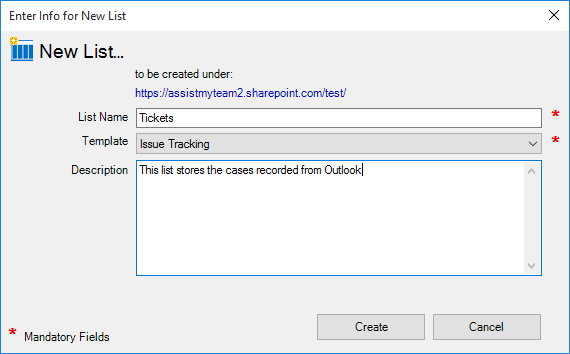
After choosing a destination SharePoint list (either by creating a new one, or by selecting an existing list), you can proceed to start mapping the fields between Outlook and SharePoint.
Here is the mapping panel which will show up and this is where you need to map fields between Outlook mail and the fields of the chosen SharePoint list.

A mapping is nothing but an association between an Outlook field (e.g., subject of the mail item) to a specific SharePoint list field (e.g., Title). You have complete control over which data goes to the SharePoint list from Outlook. In the mapping dialog box (above), the first column lists all the email fields as available in Outlook. The second column displays the data type of the field. In the last column, there is a drop-down list on each row, consisting of all available SharePoint fields. Simply choose a SharePoint field from the drop-down box to map it to the corresponding Outlook field.
For example, in the screenshot above, Outlook field ‘Subject’ is mapped to SharePoint field ‘Title’.
You can also choose to auto create the fields in the SharePoint list as well as auto-map the fields between Outlook and SharePoint.
![]() For all unmapped fields – Click this option under the ‘Auto Create & Map fields’ menu to create all the Outlook fields (that have not been mapped yet) in the chosen SharePoint list and complete the mapping automatically. If the chosen SharePoint list have any matching existing fields, instead of creating new ones, the add-in will try to use them to map with the Outlook fields. For instance, if the chosen SharePoint list was created based on the ‘Calendar’, the list already contains predefined fields such as Title, Start Date, End Date, Description etc. which could be re-used.
For all unmapped fields – Click this option under the ‘Auto Create & Map fields’ menu to create all the Outlook fields (that have not been mapped yet) in the chosen SharePoint list and complete the mapping automatically. If the chosen SharePoint list have any matching existing fields, instead of creating new ones, the add-in will try to use them to map with the Outlook fields. For instance, if the chosen SharePoint list was created based on the ‘Calendar’, the list already contains predefined fields such as Title, Start Date, End Date, Description etc. which could be re-used.
![]() For the following fields – Click this option under the ‘Auto-Create & Map fields’ menu to choose specific Outlook fields of interest that will be auto-created in the chosen SharePoint and mapped automatically.
For the following fields – Click this option under the ‘Auto-Create & Map fields’ menu to choose specific Outlook fields of interest that will be auto-created in the chosen SharePoint and mapped automatically.

Once you have chosen a SharePoint list, the mapping panel will show up and this is where you need to map fields between Outlook mail and the fields of the chosen SharePoint list.
Optionally, to have finer control, you can also manually create new fields in the chosen destination SharePoint list and map with the outlook fields.
Create New SharePoint Field – on the fly
In the drop-down list of the SharePoint field, you will also notice that there is an item ‘[NEW LIST FIELD]’. You can select this item to create a new field in the particular SharePoint list, directly from this mapping tool, so that you can map the specific Outlook field to this new SharePoint field, without requiring you to create it in your SharePoint site.

Specify a field name that you would like to appear in the SharePoint list. Only input valid characters and avoid using special characters such as symbols.

The new SharePoint field will have the same data type as that of the corresponding Outlook field.

What SharePoint permissions are required?
You should have at least ‘Contribute’ permission over the choose SharePoint lists so that add-in can publish new items from Outlook to this SharePoint list.
Likewise, you can choose SharePoint lists that will store published appointments from Outlook.

At any time, if you want to re-edit the mapping configuration of a linked SharePoint list, just select the list and click ‘Edit SharePoint Link…’.
To remove an existing fields mapping, select the particular list item and click ‘Delete SharePoint Link’ button. This will permanently remove the selected mapping settings.
NOTE: The SharePoint list associated with this mapping is not deleted.
Second Technique: Specify SharePoint lists specific for a particular Outlook folder
You can choose also SharePoint lists that will only store items published from a specific Outlook folder. This is useful, when you have a custom form defined for that particular Outlook folder, and you want to be able to publish user defined data collected from the custom form to SharePoint.
To define a SharePoint list and mapping for a specific Outlook folder, go to Personal Settings menu > ‘Configure SharePoint lists for this folder’:
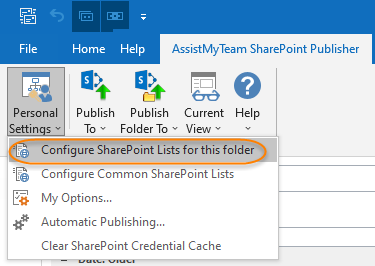
This Panel shows all the configured SharePoint list mappings done for this particular Outlook folder.

Click the ‘New SharePoint Link’ button to configure a SharePoint list for use with this particular Outlook folder (e.g., ‘Ongoing Cases’ folder). This will prompt you to enter the SharePoint site URL so that you can choose a SharePoint list and perform the mapping between the fields of this particular Outlook folder and that of the chosen SharePoint list.
Through the mapping tool, you can easily choose which fields from the Outlook items are to be published to the SharePoint list, and map fields between Outlook and the SharePoint list. Besides the standard inbuilt fields of the Outlook item type, you can also include any number of user defined fields. This mapping feature also allows you to dynamically create new field of the relevant data type in the SharePoint list, so that you can associate it with an Outlook field.
By default, the first option ‘Retrieve from the first item’ is selected, and what it does is, to probe the first item of the folder and automatically seek out all the available fields, including any number of user-defined custom fields. It is recommended that you stick with this option of displaying the fields, unless you want to retrieve Outlook specific fields only (second option) or want to use a particular custom form out of many defined for that Outlook folder (third option).
If you select the second option ‘Default form’, it will list all the inbuilt fields associated with the particular Outlook item type. For example, Mail type.
Likewise, if you select the third option ‘Custom Form’, it will list all the inbuilt fields, plus any user defined fields that were added by the user.
Let us consider the example of an Outlook folder that contains a custom form ‘IPM.Post.AMTSupportCase’. Assuming there are custom fields defined in that custom form, and there are hundreds of items in this folder that were generated using this custom form. So, if I want to include the custom data on these items when published to SharePoint, I can use the custom form to include and map the custom fields to the SharePoint fields. All I need to do is enter the custom form name ‘AMTSupportCase’ as shown below:

In the mapping dialog box (above), the first column lists all the Outlook fields. The second column displays the data type of the field. The third column shows if the particular field is inbuilt, or user defined. In the last column, there is a drop-down list on each row, consisting of all available SharePoint fields. Just simply choose a SharePoint field from the drop-down box to map it to the corresponding Outlook field. For example, in the screenshot above, Outlook field ‘Body’ is mapped to SharePoint field ‘Comments’.
If you have added/linked multiple SharePoint ticket lists in, you will notice that the ‘Publish To’ drop down menu shows all of them. You can then simply choose the destination SharePoint list to which the selected Outlook items will be published.

NOTE: There are other configurations that you would need to undertake. These options are available in the ‘Personal Settings…’ drop down menu > Preferences of the SharePoint Publisher toolbar or ribbon in Outlook.
For more references and helps on performing these administrative configurations, refer to the PDF Help Manual, which can be invoke from the Outlook > SharePoint Publisher toolbar or ribbon > Help > Help Topics.
PDF versions of this installation guide is available for download here.
